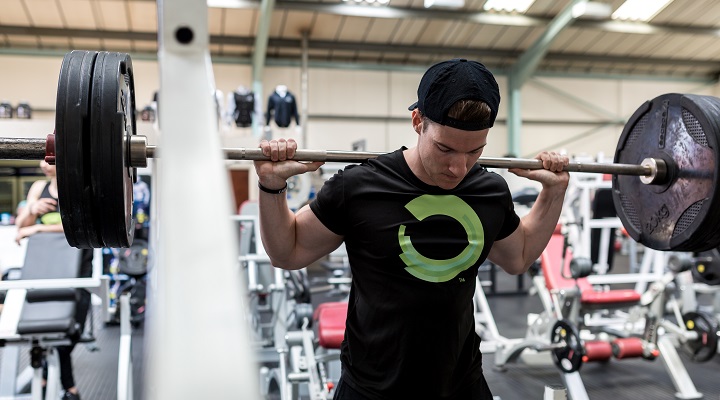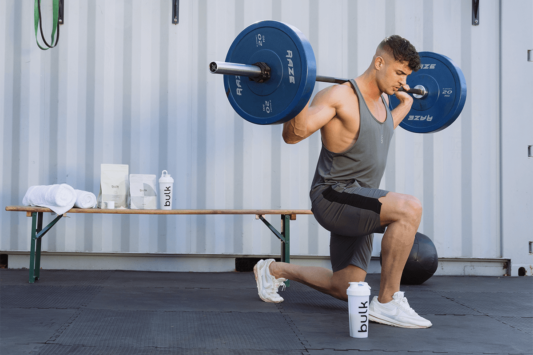Pyramid training is a collection of sets, of the same exercise, that start with lightweight and higher reps, building up to a heavier weight and fewer reps. A full pyramid training set is an extension of this, reducing the weight after you have reached the peak until you complete the pyramid. Sometimes pyramid training only accounts for the upward sets. In this instance, we’ll cover full pyramid sets: building up from a lightweight/high reps to a peak weight / low reps, and then reducing the weight and increasing reps again on the way down.
Different set ranges work for different people. A beginner might start with a basic 3 set pyramid, an intermediate level athlete might opt for 5 sets, and an advanced gym goer may tackle an ambitious 7 sets.
Here is an example of an intermediate level.
Starting at approximately 60% of your 1RM
Set 1 – 12 reps / 60%
Set 2 – 10 reps / 70%
Set 3 – 8 reps / 80% (peak – heaviest set)
Set 4 – 10 reps / 70%
Set 5 – 12 reps OR to failure / 60%
What are the benefits of pyramid training?
Pyramid training is quite time-efficient, dependent on the number of sets you choose to complete in a workout. The upside of longer sets is that you fatigue the target muscle group through a variety of rep and weight ranges, forcing your muscles to adapt and grow. You know you’ve just worked hard – you can feel and hear your muscles screaming. Good luck getting dressed later…
Keep intensity high by limiting the rest time between sets. This keeps the muscles active and under tension for longer, causing more micro-tears in the muscle fibres – just what you need to promote muscle protein synthesis – the rebuilding process for new, stronger muscle.
Pyramid training is also perfect if you’ve hit a plateau in the gym. If you’ve noticed your progress is slowing, pyramid training is a great way of shocking your muscles with a new stimulus, to promote growth and development.
Tips for successful pyramid training.
Don’t be overzealous with your starting weight. Pyramid training covers all bases, strength, hypertrophy and muscular endurance, so picking a weight that is too heavy from the start will result in early fatigue and a loss of form.
Experiment with a starting weight of approximately 60% of your 1RM for that exercise, and increase the weight for each set by increments that fit your goals. If you’re tackling a tough 7 set pyramid, try smaller increments, to begin with, and build these up over time.
If your form starts to waiver, reduce the weight and try to maintain the target reps per set to ensure you’re still hitting the volume required.
If you have anything left in the tank at the end of the session, push for absolute failure on the final set. Don’t be restricted by the planned reps – go to town! The struggle is real…
Pyramid training progressions.
There are a number of different ways you can incorporate pyramid training progressions. Here are just a few examples:
- Increase the total volume – start at 3 sets and progress to 7 as you build up your strength and endurance.
- Increase the starting weight – maintain a consistent set range but increase your starting weight each week.
- Increase the weight increments between sets – go from 5kg extra per set to 10kg, or increase by a % that works for you.
- Reduce the rest between sets – keep this to a minimum of 1 minute if you’re a beginner but as you gain confidence, try reducing rest periods to create a greater catalyst.
If you’re serious about training, create a pyramid training plan and incorporate any of the example progressions above. It’s wise to keep a track of what you’re doing each week, working to a plan (4 weeks is a good amount of time to factor in progressions). If you just turn up to the gym and forget about your starting weights, set volumes etc, you’ll quickly lose sight of what you’re trying to achieve, and where any obvious weaknesses lie.
Build muscle and recovery strong with supplements and foods.
AFTERMATH™ is the perfect post-workout supplement to recovery from intensive pyramid training. Its premium source of whey protein and carbohydrates guarantees rapid amino acid and glycogen store replenishment.
Nut butters are a fantastic source of protein and fats if you’re trying to ramp up your exercise output. They are the perfect calorie-dense food source – our Peanut Butter and Almond Butter are both popular, great tasting, and good for your health too.
But don’t overlook vitamin gains. If you’re pushing your body hard it’s important to support your immune system. Our Complete Multivitamin Complex™ is ideal for a vitamin and mineral top-up, especially when you are fatigued from training. Supplement with additional Vitamin C and Vitamin D3 if needed, to further aid recovery.
Give it a try.
Struggling for motivation, not sure what to do at the gym, or in danger of hitting a training plateau? Then why not give Pyramid Training a try? It’s perfect for all body parts, but works extremely well for chest, back and leg routines. Hit the bigger muscle groups hard and watch your gains skyrocket! Good luck!









